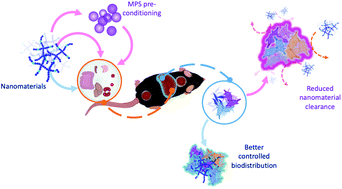Nanoparticle based medicines: approaches for evading and manipulating the mononuclear phagocyte system and potential for clinical translation
Abstract
For decades, nanomedicines have been reported as a potential means to overcome the limitations of conventional drug delivery systems by reducing side effects, toxicity and the non-ideal pharmacokinetic behaviour typically exhibited by small molecule drugs. However, upon administration many nanoparticles prompt induction of host inflammatory responses due to recognition and uptake by macrophages, eliminating up to 95% of the administered dose. While significant advances in nanoparticle engineering and consequent therapeutic efficacy have been made, it is becoming clear that nanoparticle recognition by the mononuclear phagocyte system (MPS) poses an impassable junction in the current framework of nanoparticle development. Hence, this has negative consequences on the clinical translation of nanotechnology with respect to therapeutic efficacy, systemic toxicity and economic benefit. In order to improve the translation of nanomedicines from bench-to-bedside, there is a requirement to either modify nanomedicines in terms of how they interact with intrinsic processes in the body, or modulate the body to be more accommodating for nanomedicine treatments. Here we provide an overview of the current standard for design elements of nanoparticles, as well as factors to consider when producing nanomedicines that have minimal MPS–nanoparticle interactions; we explore this landscape across the cellular to tissue and organ levels. Further, rather than designing materials to suit the body, a growing research niche involves modulating biological responses to administered nanomaterials. We here discuss how developing strategic methods of MPS ‘pre-conditioning’ with small molecule or biological drugs, as well as implementing strategic dosing regimens, such as ‘decoy’ nanoparticles, is essential to increasing nanoparticle therapeutic efficacy. By adopting such a perspective, we hope to highlight the increasing trends in research dedicated to improving nanomedicine translation, and subsequently making a positive clinical impact.

- This article is part of the themed collection: Biomaterials Science Recent HOT Articles


 Please wait while we load your content...
Please wait while we load your content...